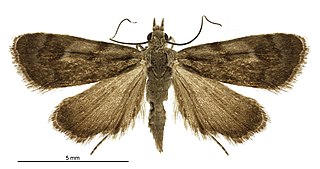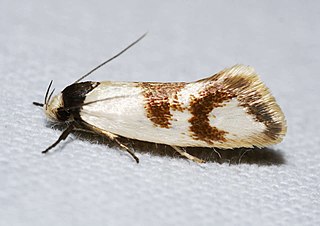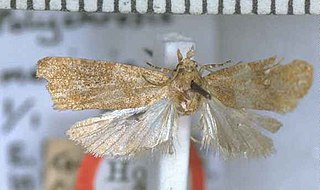Original description
Female, 12-13 mm. Head and palpi whitish-ochreous, vertex sometimes white; palpi short, not reaching vertex, second joint loosely scaled. Antennae grey, towards base whitish-ochreous. Thorax and abdomen ochreous-brown. Legs whitish-ochreous. Forewings elongate-triangular, costa nearly straight; apex round-pointed, termen slightly rounded, oblique; reddish-brown; a narrow inwardly oblique white fascia from mid-costa to dorsum at 2/3, followed by a broader grey suffusion; cilia white, mixed with fuscous-brown. Hindwings with termen rounded; veins 3 and 4 stalked; grey; cilia grey. Townsville, Q.; in May, July, and August; three specimens received from Mr. F. P. Dodd.
— Original description by Turner

Halpe homolea, the Indian ace or Ceylon ace, is a butterfly belonging to the family Hesperiidae.
Poecilasthena cisseres is a moth of the family Geometridae first described by Alfred Jefferis Turner in 1933. It is found in Australia, including Victoria.
Xyroptila peltastes is a moth of the family Pterophoridae. It is found in Australia.
Eublemma rufipuncta is a moth of the family Noctuidae first described by Alfred Jefferis Turner in 1902. It is found in Australia.

Asterivora iochondra is a species of moth in the family Choreutidae. It is endemic to New Zealand and was first described by Edward Meyrick in 1911. This species has been observed in both the North and South Island at Mount Holdsworth and Mount Arthur. This species inhabits open spaces on mountains on the forest edge at 3000 ft altitude. Adults of this species are on the wing in February and flies rapidly in sunshine.

Lichenaula lichenea is a species of moth of the family Xyloryctidae. It is known in Australia from the Australian Capital Territory, New South Wales and Queensland.

Agdistopis halieutica is a moth in the Macropiratidae family. It is found from Australia and New Guinea to Fiji.
Ceromitia benedicta is a species of moth of the family Adelidae. It was first described in 1918 by Edward Meyrick and is known from South Africa.

Apoctena orthocopa, also known as striped ponga leaf-tyer, is a species of moth of the family Tortricidae. It is endemic to New Zealand, where it is found only on the North Island.

Glaucocharis stella is a species of moth in the family Crambidae. It is endemic to New Zealand.
Tanycnema is a monotypic moth genus of the family Tineodidae or false plume moths. It was described by Alfred Jefferis Turner in 1922. Turner described the genus in Proceedings of the Royal Society of Victoria, writing:
Gen. Tanycnema, nov.
Frons with a strong anterior tuft of hairs. Tongue present. Palpi rather long, porrect. Maxillary palpi obsolete. Antennae short. Legs long, slender; outer tibial spurs about 3/4 length of inner spurs. Forewings narrow, elongate; 2 from well before angle, 3 from angle, 4 and 5 somewhat approximate at origin, 6 from upper angle, 7, 8, 9, 10 stalked, 7 arising slightly before 10, 11 free. Hindwings twice as broad as forewings; 2 from 3/4, 3 from angle, 4 and 5 somewhat approximate at origin, 6 well separated at origin from 5, still more widely from 7, 7 from upper angle, closely approximated to 12 for some distance, but not anastomosing.
A peculiar, isolated, and primitive genus. The wide separation of 6 from 7 of the hindwings, and the absence of any anastomosis of 7 with 12 are primitive characters; on the other hand the relative approximation of 5 to 4 in the hindwings, and the stalking of 7 and 10 of the forewings are specialised characters, the former being unique in this family, to which the genus must, I think, be referred, though the absence of maxillary palpi, suggests some relationship to the Pterophoridae, but this may be more apparent than real.

Ichneutica panda is a species of moth in the family Noctuidae. It is endemic to New Zealand and only found in central and southern parts of the South Island. The species has not been collected in Canterbury since the late 1950s and has not been seen at The Wilderness scientific reserve since 1941. This species is similar in appearance to Ichneutica falsidica however I. panda lack or have indistinct black dashes on their edge of their hindwings. I. panda inhabit shrubland from alpine zones down to river terraces and adults are on the wing between December and February. The life history of this species is unknown as is the host species of the larvae.

Tingena brachyacma is a species of moth in the family Oecophoridae. It is endemic to New Zealand and has been found in the south of the South Island. This species inhabits open swamps, native forest and scrubland and has been collected amongst Leptospermum. The adults of the species are on the wing in November and December.

Tingena eumenopa is a species of moth in the family Oecophoridae. It is endemic to New Zealand and found in the North and South Islands. The adults have been found amongst tree ferns and are on the wing in December.

Tingena falsiloqua is a species of moth in the family Oecophoridae. It is endemic to New Zealand and has been collected in the North Island. This species frequents subalpine native forest.

Tingena hastata is a species of moth in the family Oecophoridae. It is endemic to New Zealand and has been observed in the southern part of the South Island. Adults of this species are on the wing in October.

Tingena penthalea is a species of moth in the family Oecophoridae. It is endemic to New Zealand and has been observed in Wellington and the Tararua Range. The adults of this species are on the wing from December until February.

Antipterna trilicella is a species of moth in the family Oecophoridae, first described by Edward Meyrick in 1885 as Ocystola trilicella. It appears to be a moth endemic to Australia and confined to the east coast, occurring in Victoria, New South Wales and Queensland.

Polychrosis meliscia is a species of moth of the family Tortricidae. It is found in New Zealand at the Kermadec Islands.

Trachypepla importuna is a moth of the family Oecophoridae first described by Edward Meyrick in 1914. It is endemic to New Zealand. Adults have been collected in the North Island in January but the species is regarded as being poorly known.
This page is based on this
Wikipedia article Text is available under the
CC BY-SA 4.0 license; additional terms may apply.
Images, videos and audio are available under their respective licenses.














